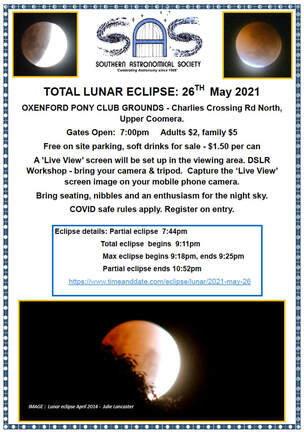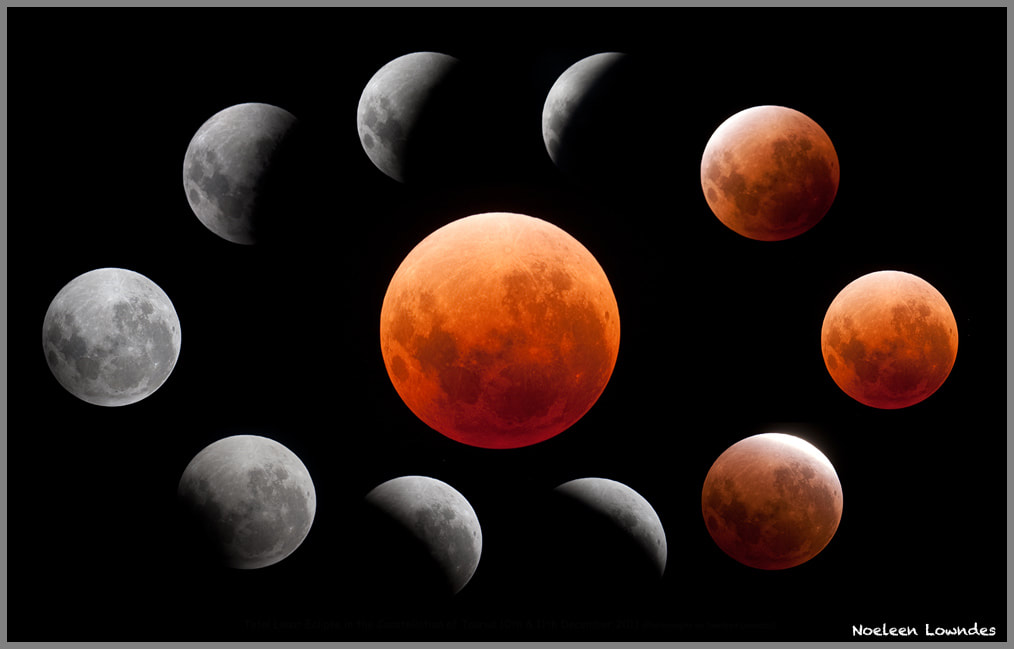 ~ SAS is holding a Lunar Eclipse event on the 26th May 2021 from 7.00pm ~
~ SAS is holding a Lunar Eclipse event on the 26th May 2021 from 7.00pm ~ This is the first total eclipse of the Moon to been seen here on the Gold Coast in Australia since 2018. Lunar eclipses are such wonderful celestial events to witness and completely safe to view through your binoculars or telescope.
This month’s full Moon is again special because it’s the second Super Moon or perigee Moon for the year, which means because of the Moon’s elliptical orbit around the Earth it’s much closer to our planet in distance.
For you to enjoy the event you’ll only need to go out into your own garden and look up at the Full Moon that will be to the north-eastern part of the sky, by the time the eclipse begins the Moon will be quite high up in the sky.
You don’t need any fancy equipment to thoroughly enjoy this wonderful astronomical event, you can simply view the eclipse with your eyes or better still use a pair of binoculars, if you have a telescope than that’s even better, but it’s not a necessity.
A lunar eclipse is completely safe to view, as it’s reflected sunlight off the surface of the Moon, unlike a solar eclipse, which is very dangerous to look at with your eyes without proper solar glasses or filters.
The whole event moves quite slowly and this eclipse lasts from beginning to end just over 5 hours…so you’ll have plenty of time to relax and enjoy the wonderful spectacle.
If you have children the best time to view the event will be from 8pm until 9.30pm that is when you will see the Moon in partial shadow and the stunning colours of the Moon in total eclipse :-)
What time will you see the Lunar Eclipse?
The beginning of the eclipse (AEST) (penumbral) begins at 6.46pm and by 7.45pm you’ll really start to see the eclipsed Moon moving into the Earths shadow.
By 9.10pm the Moon will be fully eclipsed with greatest eclipse (Totality) being at 9.19pm where you will see the darkest reddish/orange hue, total eclipse ends at 9.28pm. (Because the Moon will only make a shallow pass into the Earths shadow the lunar disc will remain quite bright along the northern limb)
After that, the eclipse all goes in reverse and takes another 2 hours for the Moon to move away from the Earths shadow, by 11.51pm a beautiful silvery full Moon will be back in our night sky.
If your taking images, you can use your longest telephoto lens with your camera on a tripod, and use a cable release (or your camera timer) so you don’t touch the camera, also remember to manual focus. You’ll only need to take short exposures when the Moon is very bright in the early partial stages, but at full eclipse be prepared to take exposures for a few seconds, as there’s very little light on the surface of the Moon.
All lunar eclipses are different, it all depends how much dust, smoke or moisture is in the atmosphere that determines how dark or light the eclipsed Moon will look. The only reason we are seeing the Moon at all is because the Suns light is being refracted through the Earths atmosphere and shining onto the surface of the Moon while it's orbiting through the Earths shadow.
If you would like to go out and enjoy the lunar eclipse away from your home, you can find any one of the beautiful parks around the Gold Coast that have a clear sky to the north and take blankets and warm drinks to enjoy. If you have a sun shelter or tepee tent they are great for the little ones to lie down in while the older members enjoy the event.
Our Southern Astronomical Society (SAS) here on the Gold Coast is holding a public field night in the grounds of our meeting rooms at Oxenford starting at 7.00pm, please find the information below:
Afternoon event for children aged 10+ -
https://new.goldcoast.qld.gov.au/libraries/Home?trumbaEmbed=view%3Devent%26eventid%3D152505875
Evening event for adults -
https://new.goldcoast.qld.gov.au/libraries/Home?trumbaEmbed=view%3Devent%26eventid%3D152505158
Whatever way you decide to view the lunar eclipse, have lots of fun and enjoy this Amazing astronomical event, Noeleen :-)


 RSS Feed
RSS Feed
